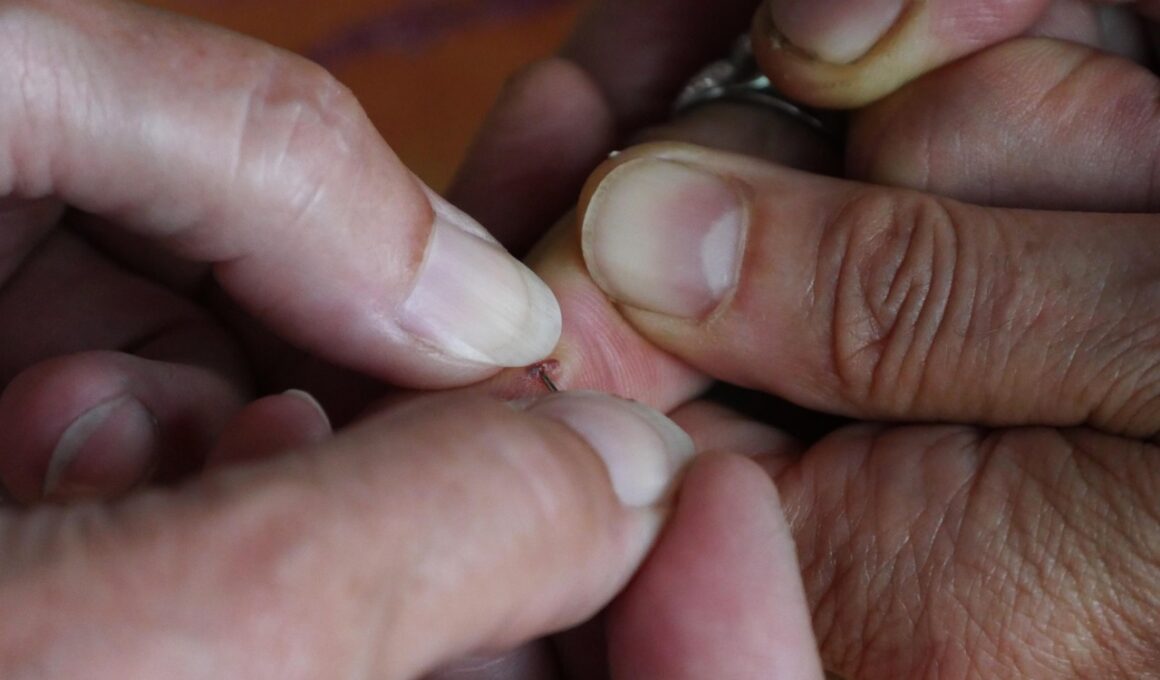How to Avoid Infection While Treating Cat Bleeding
Addressing cat bleeding promptly is crucial. If your feline has sustained a wound that causes bleeding, it’s essential to take immediate actions to minimize infection risks. Begin by thoroughly washing your hands to avoid introducing bacteria to the wound area. Utilize warm water and soap, followed by drying them with a clean towel. Next, approach your cat with a calm demeanor, as your furry friend may be distressed. Understand that allowing them to remain relaxed can help facilitate effective first aid. Always have your first aid kit ready, accessible, and well-stocked. Keep sterile gauze pads, bandages, antiseptic wipes, and adhesive tape close at hand. It is in these moments that efficient organization can make all the difference in stabilization and treatment. Gently clean the wound using a sterile saline solution, ensuring no debris is left behind to promote healing. If you observe significant bleeding that doesn’t stop, seek veterinary assistance immediately. Always have an emergency veterinary contact ready, as prompt professional intervention may sometimes be necessary to prevent infection. Taking proactive steps ensures your pet receives proper care.
After addressing the immediate bleeding, it’s essential to monitor the wound closely. Observe for signs of infection, which may include swelling, redness, or discharge. If any of these symptoms arise, collect details before consulting a vet. Documenting the wound’s appearance and your actions can help provide context to your veterinarian. Maintaining an appropriate environment for your cat is another critical consideration. Keep the cat confined to an area where they cannot further irritate the injury site. Limiting movement and activity aids in the healing process while reducing the risk of infection. When possible, use an Elizabethan collar to prevent your cat from licking the wound. This action can safeguard against added bacteria from their mouths, which may worsen their condition. Providing a comfortable resting space at home can also hasten recovery. Soft bedding and quiet surroundings ensure your cat feels safe and secure. Additionally, maintain regular checkups with a vet during this period. These assessments will allow for a thorough examination, promoting the best chance for complete recovery without complications. Not only does this provide peace of mind, but it can also help avert longer-term health issues.
Essential Supplies for Cat First Aid
Having the right supplies for cat first aid can make a significant difference in treatment outcomes. Assemble a comprehensive first-aid kit tailored specifically for feline needs. Include sterile gauze pads and adhesive bandages of various sizes. These items are crucial for dressing wounds and preventing infection. Consider also integrating an antiseptic solution, safe for pets, to cleanse any wounds without causing further irritation. Furthermore, a pair of scissors can assist in cutting tape or gauze when needed. It’s crucial that these scissors are not too sharp to avoid accidental injury during treatment. Also, prioritize obtaining latex or nitrile gloves. Using gloves during treatment reduces the potential of transferring bacteria from your hands to the open wound. Always remember to replace any used supplies to maintain the kit’s effectiveness. Including a reference guide can also prove beneficial, providing quick information on basic first-aid steps. Take a moment to familiarize yourself with using each item in the kit. Familiarity ensures better response when faced with emergencies, allowing you to act quickly and efficiently, ultimately protecting your beloved pet.
In addition to having the essential supplies, educating yourself about how to use them is equally important. Familiarize yourself with various wound types and appropriate first-aid responses. This knowledge can empower you to take decisive action when required. Consider enrolling in a pet first-aid class. Such classes provide hands-on experience and can enhance your understanding of feline anatomy and effective treatment techniques. Knowledge gained from these courses can significantly benefit you and your pet in critical situations, ensuring you feel ready to handle emergencies competently. Additionally, practicing calming techniques can help you maintain composure and effectively reassure your pet during stressful moments. Your calm presence can greatly influence their behavior, making treatment smoother. Also, develop a solid understanding of basic cat anatomy to quickly identify problematic areas. Knowing which areas are sensitive can help you manage treatment with minimal discomfort. Furthermore, sharing your knowledge with other cat owners promotes a community of informed guardians who can act in their pets’ best interests. Together we can create a supportive network that prioritizes timely and quality care during emergencies involving our beloved companions.
Understanding Wound Types
Not all wounds in cats are the same, and identifying the type can influence the treatment method. Generally, wounds can be categorized as abrasions, lacerations, puncture wounds, or bites. Abrasions are superficial injuries to the skin’s top layer, often healing quickly. However, ensuring proper cleaning is essential to avoid infection risks. Lacerations are deeper cuts that require careful attention to cleaning and dressing. It’s crucial to apply a sterile bandage to protect the area against bacteria. Puncture wounds often come from bites or sharp objects. Since they can introduce bacteria deep into tissues, veterinary attention is typically needed to prevent complications. Understanding the type of wound is essential to determine the best treatment. Cat bites can be particularly serious due to the risk of abscess formation. Always consult your vet if the wound is deep, particularly if it bleeds heavily or shows signs of infection. Each type of injury requires different cleaning techniques, follow-up care, and monitoring. Therefore, being informed allows you to provide appropriate care, minimizing the risk of infection and promoting your cat’s healing.
Cats can often hide pain and injury, making it challenging to assess their condition accurately. Regular checks and monitoring are essential, especially if there’s a known injury. Keeping a close eye on your pet will help you notice any changes in behavior or signs of discomfort. If your cat becomes lethargic, refuses to eat, or seems unusually withdrawn, be proactive and consult your veterinarian. Early intervention can make a significant difference in treatment effectiveness and recovery time. Pain management is also a critical consideration for injured cats. Discuss pain relief options with your veterinarian if you sense that your cat is in distress. It’s important never to administer over-the-counter human medications, as many are toxic to cats. Instead, rely on veterinary prescriptions tailored to your cat’s specific needs. Establishing a routine during recovery can help your cat’s emotional and physical well-being. Allow your furry friend to rest undisturbed in a peaceful environment, far from disruptions and potential stress triggers. A tranquil atmosphere aids healing while ensuring your feline feels secure and loved during their recovery process.
Recognizing When to Consult a Vet
In some situations, it is crucial to seek veterinary advice immediately. Signs that your cat requires professional medical attention include heavy bleeding that does not stop, a deep wound, or wounds that become increasingly red, swollen, or warm. An increased heart rate or difficulty breathing can also signal a need for urgent care. If your cat shows any unusual behavior or if you feel uncertain about how to treat them, calling your veterinarian is advisable. An experienced professional can provide specific guidance based on the severity of the injury and offer support. In cases where stitches or more advanced care are needed, a veterinarian will have the appropriate resources to handle such situations effectively. Having the contact details of an emergency veterinary clinic nearby can help in critical moments. Emergencies can arise unexpectedly, and being prepared ensures a swift response. Always prioritize your pet’s health and well-being, as bringing them to a vet can often be the difference between minor care and serious health complications. Your proactive measures can contribute immensely to a swift recovery, ensuring your furry companion can return to their playful self.
Following the procedures provided helps minimize the risk of infection while treating your cat’s bleeding. It is essential to treat the injury promptly and effectively, keeping your feline comfortable and safe. Observing typical behaviors can help you gauge their healing progress, while your proactive care promotes faster recovery. Ensuring that your home is pet-proofed can prevent future injuries, allowing them to roam safely. Emphasizing a holistic approach to your cat’s health can help avoid frequent wounds or incidents. Regular checkups at your veterinarian will help track your cat’s health, recognize potential issues in advance, and maintain their overall well-being. Prioritize aspects like nutrition, exercise, and mental stimulation, as these can significantly enhance the overall health of your beloved pet. A happy cat is typically a healthy one, and engaging in regular play helps strengthen your bond. Providing socialization opportunities also contributes positively to their ethos. Remember that your cat is not just a pet, but a cherished family member deserving of proper care and attention. Dedication to their well-being ensures a long and happy life together.


